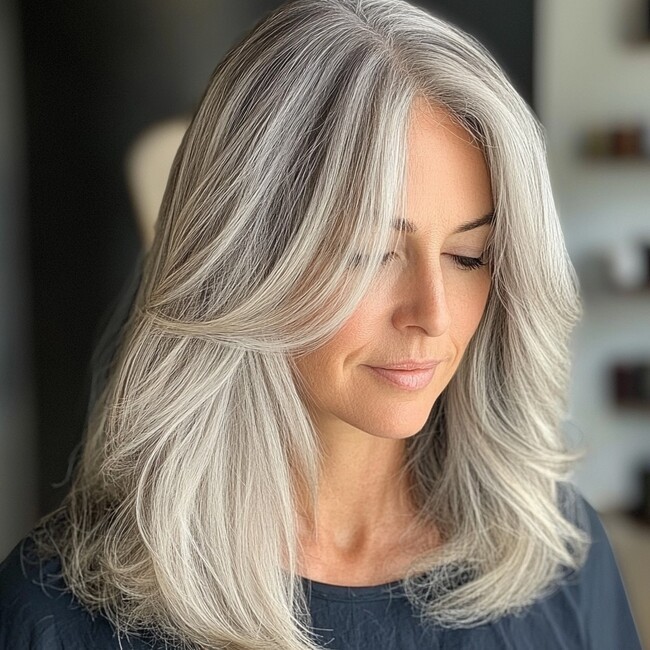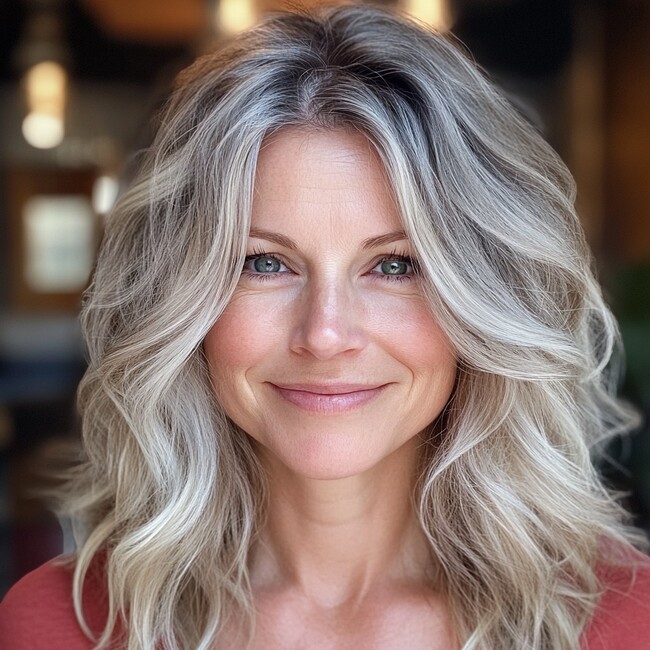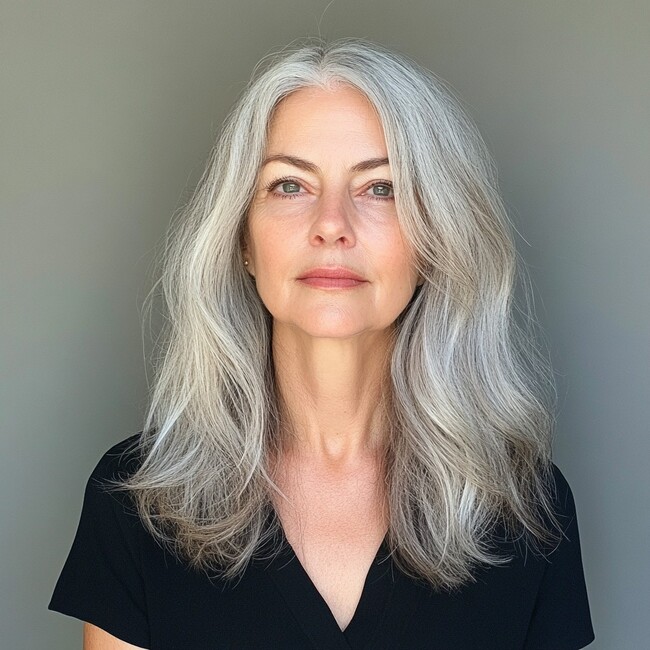Balayage Transition to Gray Hair Without the Awkward Grow-Out Phase - 20 Photos
Transitioning to gray hair used to mean either cutting it all off or enduring months of stark roots. Balayage changed that. This technique creates a seamless, natural blend between your current color and incoming gray strands.
👉 Our hair experts:
- Pavlo Smirnov has been working in the profession since 2000. Currently, he is engaged in teaching and actively developing a new network of beauty salons and a hairdressing academy in Eastern Europe.
- Sophia Bolotina is a dedicated hair professional with a deep understanding of hair care and styling. She specializes in creating personalized cuts, color transformations, and styling that enhance each client’s natural beauty.
- Tanya Garcia, a freelance makeup artist and hairstylist based in New York City, has over 10 years of experience in the industry. Specializing in makeup and hairstyling for special occasions, she also provides DIY lessons and offers personalized hair care advice.

Photo: Sophia Bolotina (Hairdresser)
But balayage isn’t the only option—highlights, lowlights, ombré, and other methods can help achieve a smooth shift. The right choice depends on hair tone, texture, and the percentage of gray you have. Here’s how to make the transition without harsh lines or high maintenance.

Photo: Barb.pro
Why Balayage Works for Gray Transition
Balayage is a hand-painted technique that creates soft, natural-looking color transitions. Unlike traditional foils, which create uniform highlights, balayage blends tones with a customized placement. This allows colorists to mimic the natural distribution of grays, making the grow-out phase less noticeable.
It’s ideal for those with 30–70% gray who want a low-maintenance solution. If hair is predominantly gray, other methods may work better to add depth and dimension. For those just starting to gray, balayage prevents the need for constant root touch-ups while keeping hair vibrant.

Photo: Sophia Bolotina (Hairdresser)
Methods for Blending Gray with Balayage
Balayage itself isn’t one-size-fits-all. Several techniques can be used to create a personalized look:
☝️Expert’s opinion:
Blending gray with balayage is an excellent way to create a natural, low-maintenance transition. I use soft, hand-painted highlights to seamlessly mix gray strands with lighter tones, adding dimension and depth. This technique allows for a graceful grow-out, reducing the need for frequent touch-ups. The key is choosing the right shades to complement the natural hair color while enhancing the overall look.
Sophia Bolotina, hair expert.
Traditional Balayage with Ash-Toned Highlights
For dark blonde or light brown hair, ash-toned highlights work best. These cool shades neutralize warmth, preventing brassy tones as the natural gray grows in.

Photo: Sophia Bolotina (Hairdresser)
- Best for: Light brunettes and dark blondes with fine to medium hair.
- Maintenance: Low. A toner refresh every few months keeps the color fresh.
Smoky Gray Balayage
For those with medium to dark brown hair, smoky gray balayage creates a sophisticated blend. This method incorporates cool-toned, deep silver pieces that gradually merge with natural grays.

Photo: Sophia Bolotina (Hairdresser)
- Best for: Dark brunettes who want a gradual transition.
- Maintenance: Moderate. A blue or purple shampoo helps maintain the cool undertones.
Rooted Balayage for a Softer Shift
Rooted balayage keeps the base color darker while adding soft, blended gray highlights. This works well for those who aren’t ready to go fully gray but want a more natural-looking transition.

Photo: Barb.pro
- Best for: Those with 50% gray or less who prefer depth near the roots.
- Maintenance: Minimal. A glossing treatment every few months prevents dullness.
Alternative Methods to Transition to Gray
While balayage is a go-to for blending gray, other coloring techniques can enhance the effect based on hair type and lifestyle.
Babylights for a Delicate Transition
Babylights are ultra-fine highlights that mimic natural sun-kissed hair. When done in a cool or silver tone, they softly blend with existing grays for a subtle transition.

Photo: Sophia Bolotina (Hairdresser)
- Best for: Fine or thin hair that can’t handle heavy bleaching.
- Maintenance: Low. Since babylights are scattered, grow-out lines remain soft.
Ombré for a Gradual Fade
Ombré transitions color from dark to light, making it an excellent option for those wanting a slow shift toward gray. This method works well for brunettes who don’t want to bleach their roots but still want an elegant silver or salt-and-pepper effect.

Photo: Sophia Bolotina (Hairdresser)
- Best for: Thick or coarse hair that can handle a heavier color application.
- Maintenance: Moderate. A toner every few months prevents yellowing.
Lowlights for Added Dimension
Lowlights add depth by introducing darker tones around existing grays. This technique is ideal for those with lighter hair who want a more balanced blend rather than an all-over silver look.

Photo: Barb.pro
- Best for: Light blondes and highlighted brunettes who need contrast.
- Maintenance: Medium. Lowlights fade slower than highlights but may need refreshing every few months.
Glossing Treatments to Enhance Natural Gray
For those with 70% or more gray, a simple glossing treatment enhances the silver tones while neutralizing yellow hues. These semi-permanent glazes add shine and depth without altering the natural gray pattern.

Photo: Barb.pro
- Best for: Those fully embracing their gray but wanting a polished finish.
- Maintenance: Minimal. Glosses fade gradually without harsh grow-out lines.
Choosing the Right Method for Your Hair Type
Not all techniques work the same for every hair type. Here’s how to determine the best approach
Fine or Thin Hair Needs a Gentle Approach
When transitioning fine or thin hair to gray, it’s important to use delicate coloring methods that won’t compromise the hair’s health. Babylights are a great option because they create ultra-fine, naturally blended highlights without the need for aggressive bleaching.

Photo: Barb.pro
Hair glossing work well too, enhancing the natural gray while neutralizing any unwanted yellow tones.

Photo: Sophia Bolotina (Hairdresser)
Soft balayage can also be effective, as long as the color placement is subtle. Because fine hair is more prone to breakage, deep conditioning treatments should be a regular part of maintenance to keep strands healthy and resilient.

Thick Hair Requires Stronger Techniques
For those with thick or coarse hair, a more structured coloring approach ensures a natural yet visible transition. Smoky balayage is a great choice, blending deep silver or cool-toned highlights into darker hair without creating harsh contrasts.

Photo: Barb.pro
Ombré techniques can also work well by gradually fading from dark roots to a soft, silvery tone at the ends.

Photo: Nadya Kats
Lowlights are particularly useful for adding dimension and depth, preventing the hair from looking flat or overly uniform. Because coarse strands tend to be drier and more resistant to color, moisturizing treatments and toning shampoos help keep the hair healthy and maintain a consistent cool-toned finish.

Photo: Sophia Bolotina (Hairdresser)
Curly Hair Blends Naturally with Gray
Curls and waves naturally diffuse color, making the transition to gray easier. Instead of harsh demarcation lines, the shape of the hair helps blend different shades effortlessly. Balayage techniques for curls work exceptionally well, as the hand-painted color follows the natural movement of the curls.

Photo: Nadya Katz
Lowlights can also add dimension, especially if there are varying levels of gray throughout the hair.

Photo: Barb.pro
Photo: Sophia Bolotina (Hairdresser) Because curly and wavy hair tends to be drier, regular hydration treatments are essential to maintain elasticity and shine. Using a sulfate-free purple shampoo can also help neutralize any brassiness without stripping moisture.
How to Maintain a Gray Balayage Transition
Once the transition is complete, proper care ensures the color remains fresh and blends smoothly:
1. Use Purple or Blue Shampoo. Gray and silver tones can develop yellow hues over time. A purple shampoo neutralizes brassiness, while a blue shampoo counteracts orange tones in darker hair.
2. Moisturize with Deep Conditioning Treatments. Bleached hair, even when blended naturally, needs hydration. A deep conditioning mask once a week keeps the strands healthy.
3. Refresh with Toners Every 8–12 Weeks. Toners maintain the cool or silver tones in balayage. Without them, gray-blended hair can fade to an uneven color.
4. Trim Regularly to Remove Old Dye. If transitioning from dyed hair, trims help remove old artificial pigment, speeding up the process.

Photo: Sophia Bolotina (Hairdresser)
When to Consider a Full Gray Transformation
For those ready to embrace their full gray, cutting off the remaining dyed hair may be the fastest option. If balayage blending has been used for months, the transition should already be smooth. A short, stylish cut can enhance the natural silver tone and eliminate the need for further coloring.

Photo: Barb.pro
Balayage offers a graceful way to transition to gray without a harsh grow-out phase. Whether using subtle highlights, smoky lowlights, or ombré effects, the right method depends on hair type, natural tone, and maintenance preferences. With proper care and the right color technique, the shift to gray can feel intentional rather than forced.

